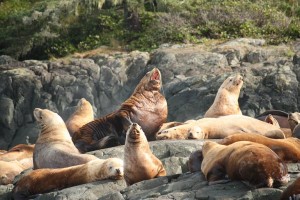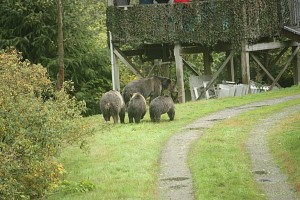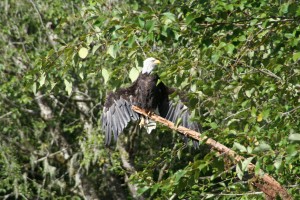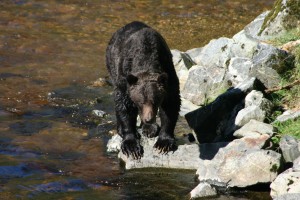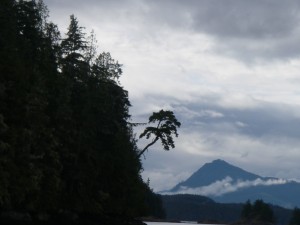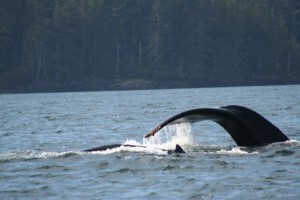All posts by Lodge Guide
Grizzly Bears sharing
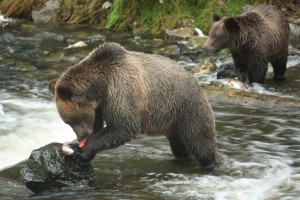
This photo by Lynn Morris shows two grizzly bears, each eating salmon, and not being concerned with the closeness of the other bear. The abundance of pink salmon means that there are few disputes over fishing rights and those are settled without bloodshed. It is estimated that there are close to fifty grizzly bears in the Glendale River valley during the peak of the pink salmon run in September. The number of salmon means that all are able to obtain enough food without risking injury by fighting. A dispute normally means that one bear will just move up of down river to another fishing area and still be able to catch enough salmon to satisfy it’s hunger.
Humpback whale fluke
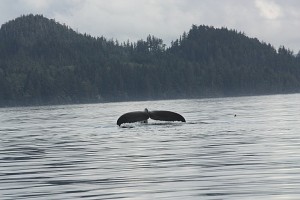
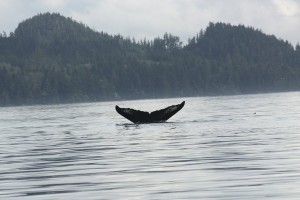 Lynn Morris from the UK provides these photos showing a humpback whale diving and showing the underside of it’s tail. The unique pattern on the tail is used to identify individual whales the same as the dorsal fin and saddle patch is used to identify the orca. The lodge’s whale watching safari area of Bold Head in Blackfish Sound normally contains eight or ten humpback whales, which feed on the herring in the area. The same herring attract the salmon, which in turn are the main attraction for the orca. It is not uncommon to be watching orca and whales at the same time, remembering these are the resident or salmon eating orca.
Lynn Morris from the UK provides these photos showing a humpback whale diving and showing the underside of it’s tail. The unique pattern on the tail is used to identify individual whales the same as the dorsal fin and saddle patch is used to identify the orca. The lodge’s whale watching safari area of Bold Head in Blackfish Sound normally contains eight or ten humpback whales, which feed on the herring in the area. The same herring attract the salmon, which in turn are the main attraction for the orca. It is not uncommon to be watching orca and whales at the same time, remembering these are the resident or salmon eating orca.
It is a keeper
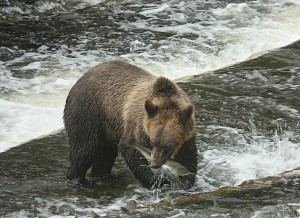
“It is a keeper” is often the first words out of a fishing guide’s mouth when guests first get the salmon to the boat. In this case the grizzly bear must be thinking the same thought, as bears are selective when deciding which salmon to keep at certain times of the season. The selection is based on “male or female”; the fat rich eggs are a prime concern to speed up the weight gain to ensure a successful hibernation. The tell tail feature for human is that male pink salmon have a rather large and distinctive hump on their back and thus the nick name “humpy”. As Lynn’s photo shows this salmon lacks the hump so it is a female and to the grizzly “it is a keeper”.
Grizzly family visit
Grizzly Bear Lodge’s tour time on the Glendale River viewing stand starts on august 25th each year. The time slot is from ten until noon this means we need to be leaving the lodge before eight to arrive at the river estuary float to give us time to transfer to shore for the fifteen minute van ride to the viewing stands. There are two wildlife viewing stands at the entrance to the man-made spawning channel and these stands are both located where the brown bears pass close by to come and catch the pink salmon. This photo taken by UK’s Lynn Morris from the second stand gives you a good idea of how close the grizzly may come to the stands when they are directly below the photo shows a rather large back as the bears tend to ignore the stands and do not normally look up.
Grizzly bears fishing?
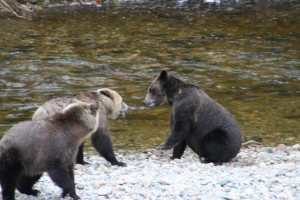
This could be mistaken for a “fight” or disagreement over the right to fish on a certain part of Knight Inlet’s Glendale River but actually it is a mother grizzly bear disciplining her second year cubs. Even sitting down you can see she has a definite weight advantage and check the size of the stomachs. This mid-October photo shows that these bears are in good shape for hibernation. The grizzly or brown bears of BC we view on our wildlife safari trips do well in hibernation because of the abundance of salmon.
Bald eagle sunning after a rain
Even eagles need to get dry. On the lodge’s wilderness tours it is not uncommon to see bald eagle with their wings spread either enjoying the sun or drying after a rain shower. Glen’s photo also shows a pretty good balancing act if you look closely this eagle is standing on one foot while spreading it’s wings. Not the average bird show.
Grizzly Bear Claws
A great photo by Glen, one of the guides, of a large male’s grizzly on the Glendale River. In spite of the black colouring it is a grizzly if you have looked at other photos post in the blog or the many on the website you will see that the bears in our grizzly bear viewing area range from one that is so blonde (cream) it is almost white to every shade of brown to almost black. The coats can be a relatively uniform colour or have markings of various shades of colours. In this case the claws are a give away they are much longer that a black bear claws. Click photo then click again to enlarge.
